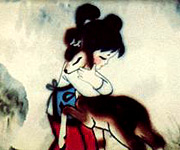| Tools: Save | Print | E-mail | Most Read |
| Traditional Ink-and-Wash Animated Films |
| Adjust font size: |
In 1960, ink-and-wash animated films appeared in China and caught the attention of the world as a breakthrough in the forms of expression and aesthetic conception in animated films. Children's films in this period employ colorful means of expression. The special effects in the science fiction and fairy-tale films unfold a brand new world for children. Chinese cartoon films have a history of over 70 years, starting with the brothers -- Wan Laiming, Wan Guchan and Wan Chaochen, who started to explore cartoon films in the 1920s and produced some short ones. Princess Iron Fan, a full-length cartoon film based on the novel of Pilgrim to the West and directed in 1941, caused a great stir in China, Japan, and the Southeast Asian countries. However, the creation of Chinese animated films stopped shortly thereafter for lack of support until the founding of new China. Tadpoles Searching for Mother and The Cowherd's Flute, two ink-and-wash films with Te Wei as the art director and Qian Jiajun as the technical director, were highly spoken of at home and abroad. Tadpoles Searching for Mother received the Best Animated Film Prize at the 1st Hundred Flower Awards and five international prizes. The Cowherd's Flute was awarded the Golden Prize at the Odense International Fairy Tale Film Festival in Denmark. Havoc in Heaven, a full-length animated film in two parts directed by Wan Laiming in the early 1960s, won the Best Film Prize at the London International Film Festival. This film is now available in more than 40 countries and regions and has received warm welcomes from Chinese and foreign audiences. The Peacock Flying Southeast, directed by Jin Xi; The Golden Conch, directed by Wan Guchan and Qian Yunda; and The Radish Comes Back directed by Tang Cheng, have won many international prizes for their artistic styles. The Deer's Bell is an ink-and-wash animated film directed by Tang Cheng and Wu Qiang in the early 1980s. The film won the Best Cartoon Film at the Third Chinese Golden Rooster Awards and a special award of cartoon film at the 13th Moscow International Film Festival in the Soviet Union in 1983. (chinaculture.org January 18, 2004)
|
| Tools: Save | Print | E-mail | Most Read |
 |
| Related Stories |
 |
|
Product Directory China Search |
Country Search Hot Buys |
